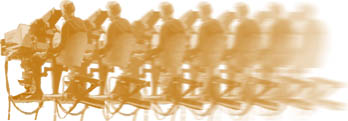
| Cameraman John Bennett has emailed kind things about this site,
and described some highlights of his personal career... " I started off with crew 5 as Jim Atkinson's personal tea-boy/cable-basher/tobacco-getter etc. On a show like Playschool, we were allowed to operate cameras (and most of the senior members of the crew were resting at home). Jim would be watching our every move from the gallery and on at least one occasion came down after the show and gave me a right bollocking in front of the whole studio (for a very minor 'headroom infringement' as I remember! It was all quite hard to take at the time but in retrospect I still feel quite proud to claim that I was 'trained' by the great man himself and since I left I have felt much gratitude and affection for Jim. Even 30 years on I still now and then hear his voice when I look down an eyepiece or a viewfinder screaming 'watch the headroom', 'why aren't you on the eyeline' (never dared ask what an "eyeline" was), 'track in closer', 'go lower', 'go wider' etc etc." I (Bernie) was also Jim's personal cable basher for a time. When we - TO25 - arrived at Television Centre in September 1966, I was put on one of the less favoured crews, and after being mostly ignored for three months, I asked Laurie Duley for a change. He sent me to crew 5, Jim's crew, and I joined proper show business. Jim was loud, irrascible, opinionated, king of his crew and most of studio drama. He and many of the big directors of the time had jointly evolved techniques which took the available equipment to its limits. The pedestal based turret camera was never going to be more flexibly used than with Jim's fluid style, with whole scenes shot on one camera in a way rarely repeated until Steadicam (see the superb plotting of The West Wing). I was warned to stay out of his way, and try not to be made his personal assistant. I had only been around for a few days when he said at the end of crewing-up "and you stay with me, lad". And then we did "Much Ado About Nothing", and "Romeo and Juliet", and "The Bloodknot" and "The Ragged Trousered Philanthropist", and "The Caretaker", and "Eugene Onegin", and various Theatre 625's that I don't have the names of. I kept the cable away from his legs, sometimes with several more senior helpers, got his tea, looked out for the fireman when he was illegally smoking in the studio, and always got to the dinner queue first - "Anything - but no fish on Monday, lad". And in return I learned more than I ever did again. Sometimes he would allow me the odd shot - on Romeo and Juliet I got a one-shot scene at the Capulet's party, and it turned out I could either be in John Cavacuiti's shot down the stairs, or in John Christie's shot along the cloisters. The play was film recorded so it still exists, with me and camera and a pile of cable down at the bottom of the stairs. By the time I was moved on, Jim was allowing me my own camera, but was always watching and giving directions. I really didn't want to leave, and I've always been proud of the fact that I learned from the very best. Though Jim was a major force in a whole era of tv drama, cameramen didn't get credits, and his endless rescuing of less talented but nevertheless famous directors - Rudi Cartier springs to mind - was never properly recognised. There's no picture of him on this site, and I don't know of any. He died some years ago of a brain tumour, and it went hardly noticed. My last real conversation with Jim was just before I left tech-ops for Presentation. He said "I told you when the spots went away you'd do well, didn't I?". Thanks, Jim. ...and, one year on since this was written, there are now some picture which include Jim - here , here and here. |
 |